Challenges of Regional Economic Integration: List of References Chapter-wise
VerifiedAdded on 2022/11/19
|10
|1945
|218
AI Summary
List of references chapter-wise for research study on Challenges of Regional economic integration and potential solutions: A case study of ASEAN. Includes references for literature review, methodology, data analysis and findings.
Contribute Materials
Your contribution can guide someone’s learning journey. Share your
documents today.
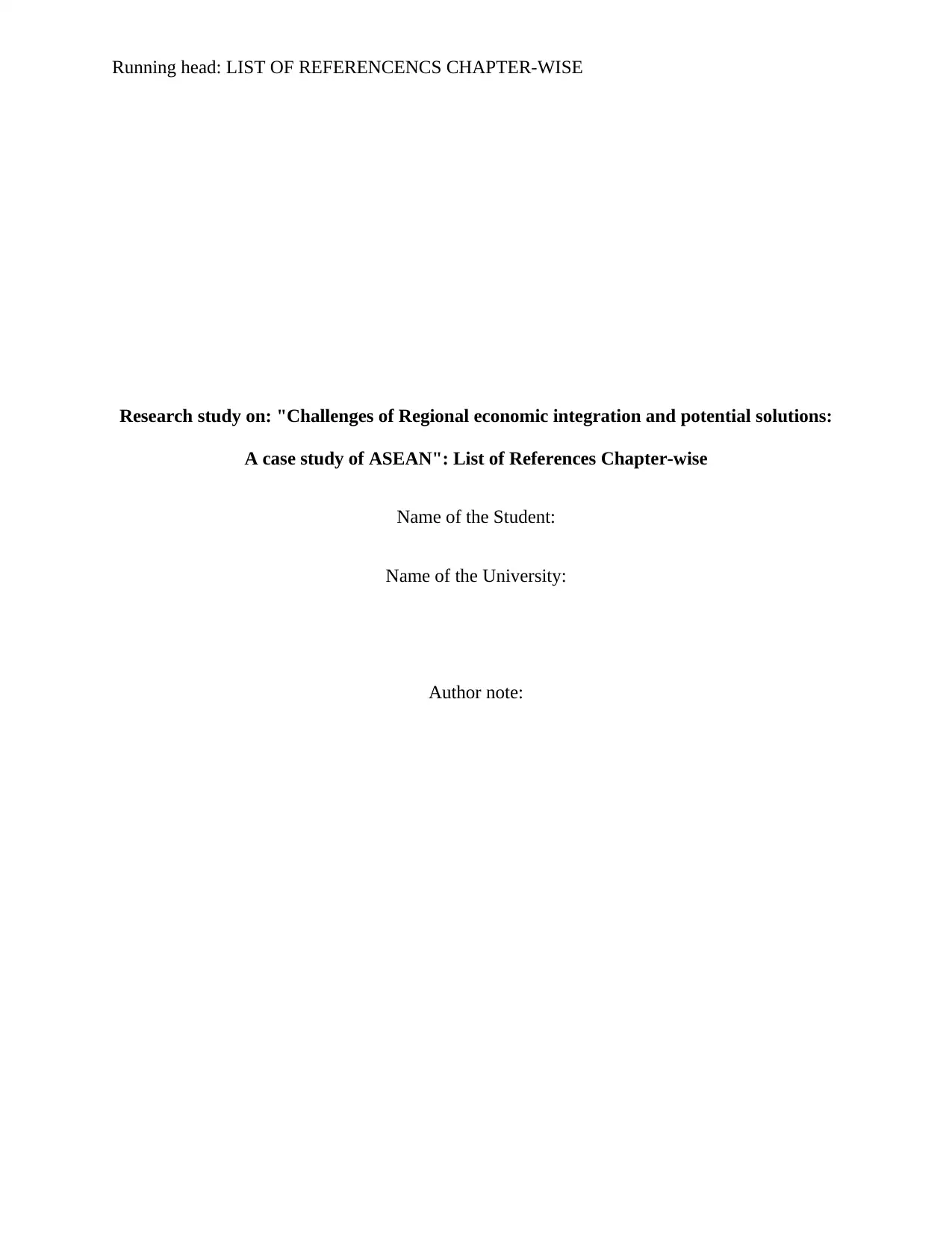
Running head: LIST OF REFERENCENCS CHAPTER-WISE
Research study on: "Challenges of Regional economic integration and potential solutions:
A case study of ASEAN": List of References Chapter-wise
Name of the Student:
Name of the University:
Author note:
Research study on: "Challenges of Regional economic integration and potential solutions:
A case study of ASEAN": List of References Chapter-wise
Name of the Student:
Name of the University:
Author note:
Secure Best Marks with AI Grader
Need help grading? Try our AI Grader for instant feedback on your assignments.
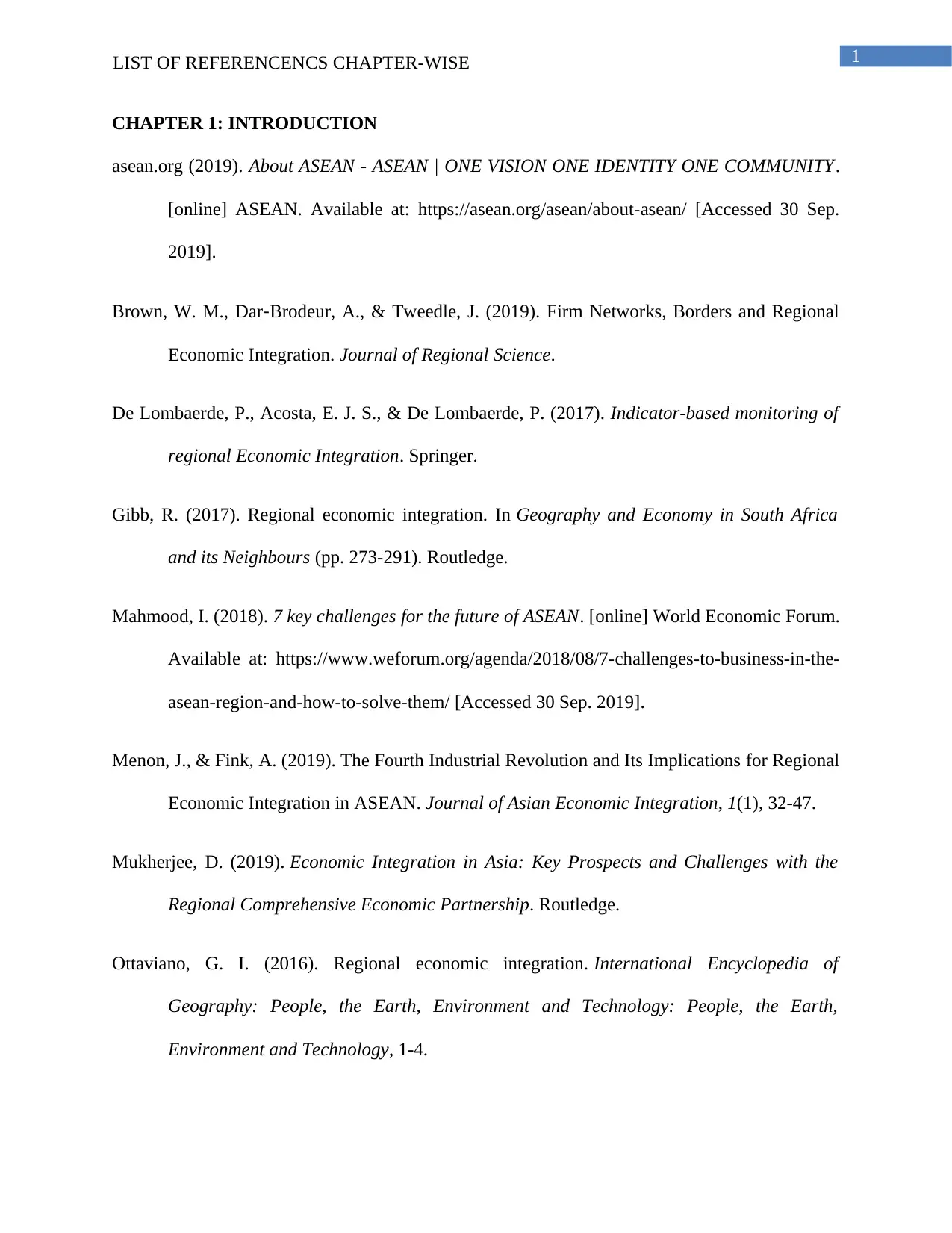
LIST OF REFERENCENCS CHAPTER-WISE 1
CHAPTER 1: INTRODUCTION
asean.org (2019). About ASEAN - ASEAN | ONE VISION ONE IDENTITY ONE COMMUNITY.
[online] ASEAN. Available at: https://asean.org/asean/about-asean/ [Accessed 30 Sep.
2019].
Brown, W. M., Dar‐Brodeur, A., & Tweedle, J. (2019). Firm Networks, Borders and Regional
Economic Integration. Journal of Regional Science.
De Lombaerde, P., Acosta, E. J. S., & De Lombaerde, P. (2017). Indicator-based monitoring of
regional Economic Integration. Springer.
Gibb, R. (2017). Regional economic integration. In Geography and Economy in South Africa
and its Neighbours (pp. 273-291). Routledge.
Mahmood, I. (2018). 7 key challenges for the future of ASEAN. [online] World Economic Forum.
Available at: https://www.weforum.org/agenda/2018/08/7-challenges-to-business-in-the-
asean-region-and-how-to-solve-them/ [Accessed 30 Sep. 2019].
Menon, J., & Fink, A. (2019). The Fourth Industrial Revolution and Its Implications for Regional
Economic Integration in ASEAN. Journal of Asian Economic Integration, 1(1), 32-47.
Mukherjee, D. (2019). Economic Integration in Asia: Key Prospects and Challenges with the
Regional Comprehensive Economic Partnership. Routledge.
Ottaviano, G. I. (2016). Regional economic integration. International Encyclopedia of
Geography: People, the Earth, Environment and Technology: People, the Earth,
Environment and Technology, 1-4.
CHAPTER 1: INTRODUCTION
asean.org (2019). About ASEAN - ASEAN | ONE VISION ONE IDENTITY ONE COMMUNITY.
[online] ASEAN. Available at: https://asean.org/asean/about-asean/ [Accessed 30 Sep.
2019].
Brown, W. M., Dar‐Brodeur, A., & Tweedle, J. (2019). Firm Networks, Borders and Regional
Economic Integration. Journal of Regional Science.
De Lombaerde, P., Acosta, E. J. S., & De Lombaerde, P. (2017). Indicator-based monitoring of
regional Economic Integration. Springer.
Gibb, R. (2017). Regional economic integration. In Geography and Economy in South Africa
and its Neighbours (pp. 273-291). Routledge.
Mahmood, I. (2018). 7 key challenges for the future of ASEAN. [online] World Economic Forum.
Available at: https://www.weforum.org/agenda/2018/08/7-challenges-to-business-in-the-
asean-region-and-how-to-solve-them/ [Accessed 30 Sep. 2019].
Menon, J., & Fink, A. (2019). The Fourth Industrial Revolution and Its Implications for Regional
Economic Integration in ASEAN. Journal of Asian Economic Integration, 1(1), 32-47.
Mukherjee, D. (2019). Economic Integration in Asia: Key Prospects and Challenges with the
Regional Comprehensive Economic Partnership. Routledge.
Ottaviano, G. I. (2016). Regional economic integration. International Encyclopedia of
Geography: People, the Earth, Environment and Technology: People, the Earth,
Environment and Technology, 1-4.
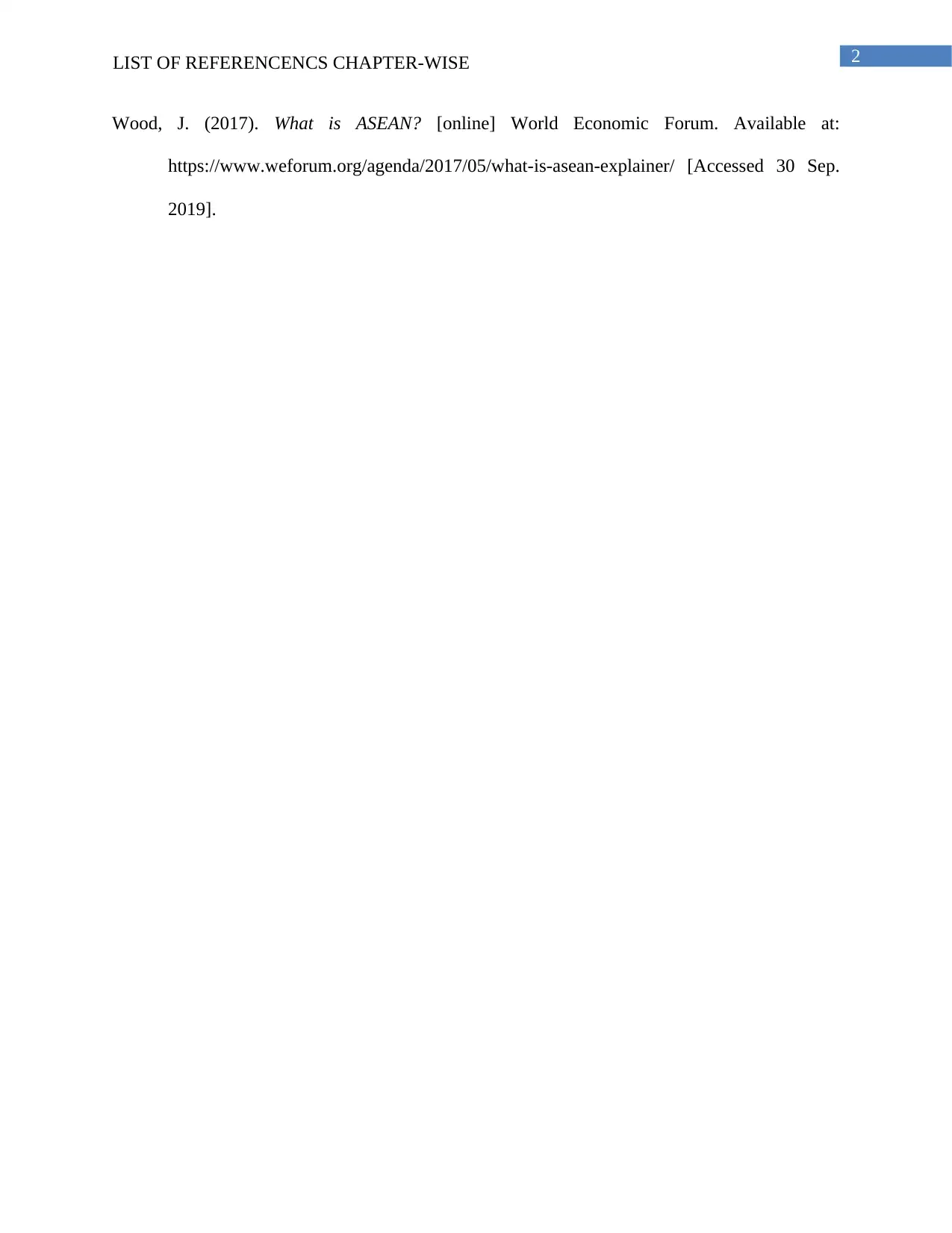
2LIST OF REFERENCENCS CHAPTER-WISE
Wood, J. (2017). What is ASEAN? [online] World Economic Forum. Available at:
https://www.weforum.org/agenda/2017/05/what-is-asean-explainer/ [Accessed 30 Sep.
2019].
Wood, J. (2017). What is ASEAN? [online] World Economic Forum. Available at:
https://www.weforum.org/agenda/2017/05/what-is-asean-explainer/ [Accessed 30 Sep.
2019].
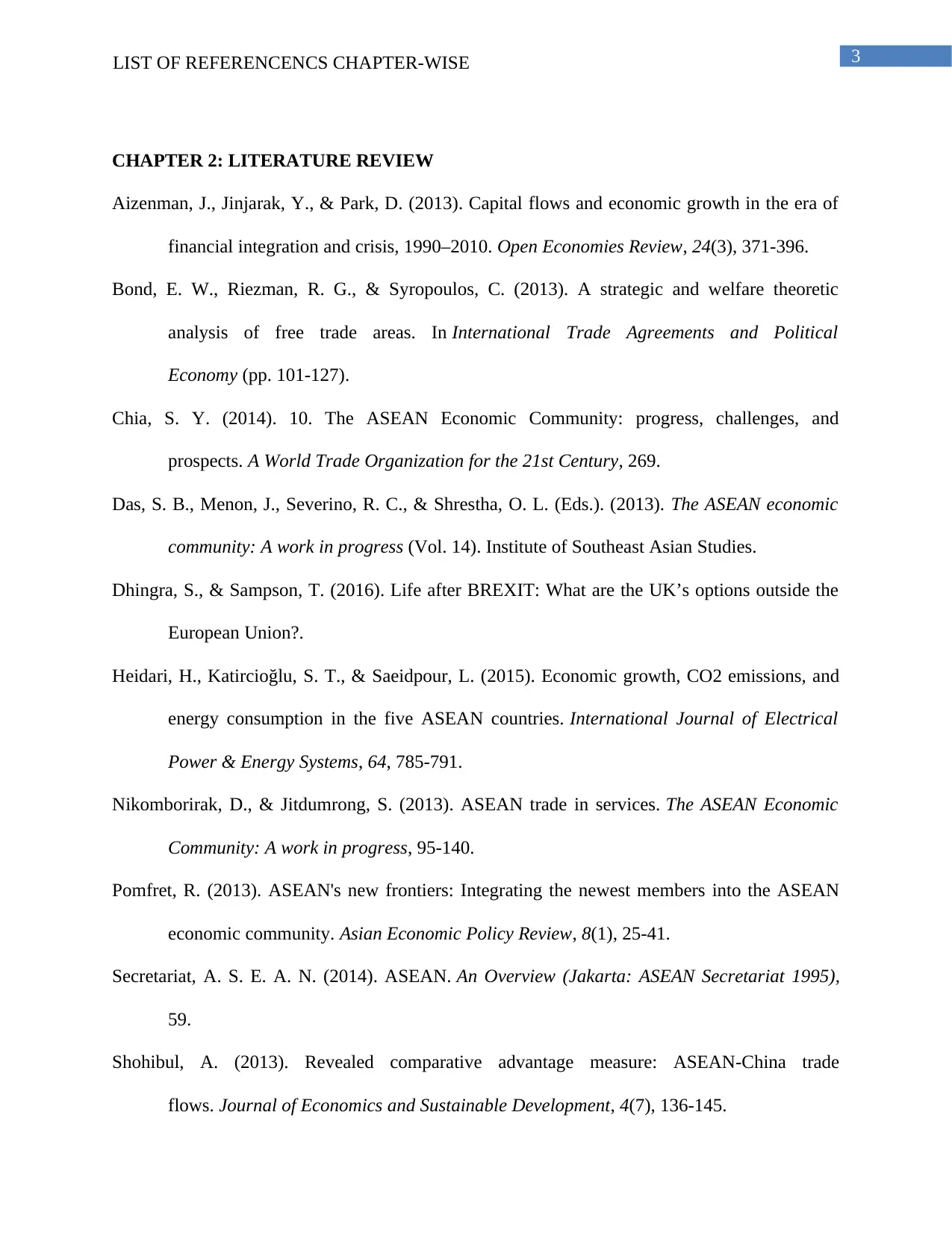
3LIST OF REFERENCENCS CHAPTER-WISE
CHAPTER 2: LITERATURE REVIEW
Aizenman, J., Jinjarak, Y., & Park, D. (2013). Capital flows and economic growth in the era of
financial integration and crisis, 1990–2010. Open Economies Review, 24(3), 371-396.
Bond, E. W., Riezman, R. G., & Syropoulos, C. (2013). A strategic and welfare theoretic
analysis of free trade areas. In International Trade Agreements and Political
Economy (pp. 101-127).
Chia, S. Y. (2014). 10. The ASEAN Economic Community: progress, challenges, and
prospects. A World Trade Organization for the 21st Century, 269.
Das, S. B., Menon, J., Severino, R. C., & Shrestha, O. L. (Eds.). (2013). The ASEAN economic
community: A work in progress (Vol. 14). Institute of Southeast Asian Studies.
Dhingra, S., & Sampson, T. (2016). Life after BREXIT: What are the UK’s options outside the
European Union?.
Heidari, H., Katircioğlu, S. T., & Saeidpour, L. (2015). Economic growth, CO2 emissions, and
energy consumption in the five ASEAN countries. International Journal of Electrical
Power & Energy Systems, 64, 785-791.
Nikomborirak, D., & Jitdumrong, S. (2013). ASEAN trade in services. The ASEAN Economic
Community: A work in progress, 95-140.
Pomfret, R. (2013). ASEAN's new frontiers: Integrating the newest members into the ASEAN
economic community. Asian Economic Policy Review, 8(1), 25-41.
Secretariat, A. S. E. A. N. (2014). ASEAN. An Overview (Jakarta: ASEAN Secretariat 1995),
59.
Shohibul, A. (2013). Revealed comparative advantage measure: ASEAN-China trade
flows. Journal of Economics and Sustainable Development, 4(7), 136-145.
CHAPTER 2: LITERATURE REVIEW
Aizenman, J., Jinjarak, Y., & Park, D. (2013). Capital flows and economic growth in the era of
financial integration and crisis, 1990–2010. Open Economies Review, 24(3), 371-396.
Bond, E. W., Riezman, R. G., & Syropoulos, C. (2013). A strategic and welfare theoretic
analysis of free trade areas. In International Trade Agreements and Political
Economy (pp. 101-127).
Chia, S. Y. (2014). 10. The ASEAN Economic Community: progress, challenges, and
prospects. A World Trade Organization for the 21st Century, 269.
Das, S. B., Menon, J., Severino, R. C., & Shrestha, O. L. (Eds.). (2013). The ASEAN economic
community: A work in progress (Vol. 14). Institute of Southeast Asian Studies.
Dhingra, S., & Sampson, T. (2016). Life after BREXIT: What are the UK’s options outside the
European Union?.
Heidari, H., Katircioğlu, S. T., & Saeidpour, L. (2015). Economic growth, CO2 emissions, and
energy consumption in the five ASEAN countries. International Journal of Electrical
Power & Energy Systems, 64, 785-791.
Nikomborirak, D., & Jitdumrong, S. (2013). ASEAN trade in services. The ASEAN Economic
Community: A work in progress, 95-140.
Pomfret, R. (2013). ASEAN's new frontiers: Integrating the newest members into the ASEAN
economic community. Asian Economic Policy Review, 8(1), 25-41.
Secretariat, A. S. E. A. N. (2014). ASEAN. An Overview (Jakarta: ASEAN Secretariat 1995),
59.
Shohibul, A. (2013). Revealed comparative advantage measure: ASEAN-China trade
flows. Journal of Economics and Sustainable Development, 4(7), 136-145.
Secure Best Marks with AI Grader
Need help grading? Try our AI Grader for instant feedback on your assignments.

4LIST OF REFERENCENCS CHAPTER-WISE
Tan, B. W., & Tang, C. F. (2016). Examining the causal linkages among domestic investment,
FDI, trade, interest rate and economic growth in ASEAN-5 countries. International
Journal of Economics and Financial Issues, 6(1), 214-220.
Tongzon, J. L., & Lee, S. Y. (2015). The challenges of economic integration: the case of
shipping in ASEAN countries. The Pacific Review, 28(4), 483-504.
Volz, U. (2013). ASEAN financial integration in the light of recent European
experiences. Journal of Southeast Asian Economies, 124-142.
Yang, S., & Martinez-Zarzoso, I. (2014). A panel data analysis of trade creation and trade
diversion effects: The case of ASEAN–China Free Trade Area. China Economic
Review, 29, 138-151.
Tan, B. W., & Tang, C. F. (2016). Examining the causal linkages among domestic investment,
FDI, trade, interest rate and economic growth in ASEAN-5 countries. International
Journal of Economics and Financial Issues, 6(1), 214-220.
Tongzon, J. L., & Lee, S. Y. (2015). The challenges of economic integration: the case of
shipping in ASEAN countries. The Pacific Review, 28(4), 483-504.
Volz, U. (2013). ASEAN financial integration in the light of recent European
experiences. Journal of Southeast Asian Economies, 124-142.
Yang, S., & Martinez-Zarzoso, I. (2014). A panel data analysis of trade creation and trade
diversion effects: The case of ASEAN–China Free Trade Area. China Economic
Review, 29, 138-151.
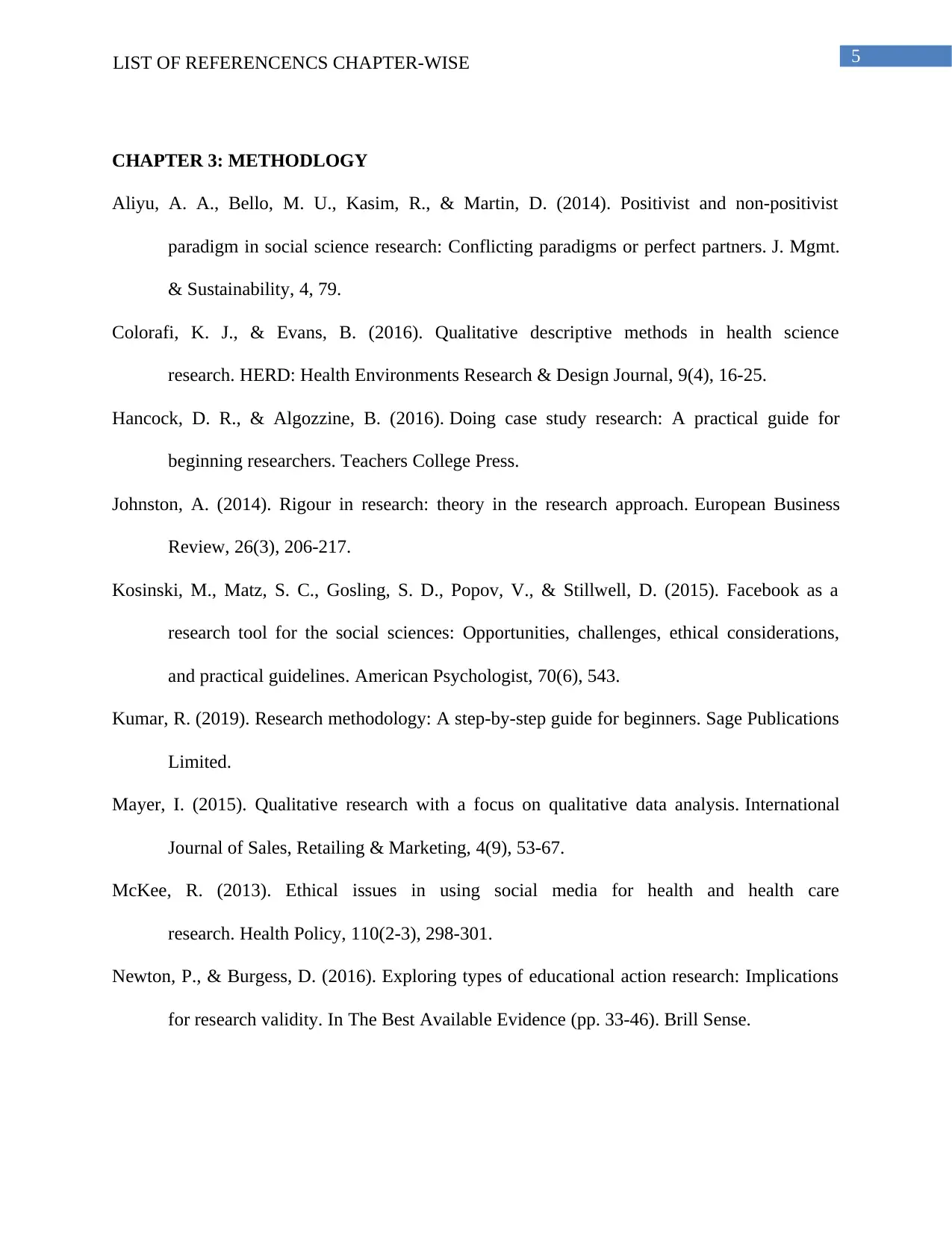
5LIST OF REFERENCENCS CHAPTER-WISE
CHAPTER 3: METHODLOGY
Aliyu, A. A., Bello, M. U., Kasim, R., & Martin, D. (2014). Positivist and non-positivist
paradigm in social science research: Conflicting paradigms or perfect partners. J. Mgmt.
& Sustainability, 4, 79.
Colorafi, K. J., & Evans, B. (2016). Qualitative descriptive methods in health science
research. HERD: Health Environments Research & Design Journal, 9(4), 16-25.
Hancock, D. R., & Algozzine, B. (2016). Doing case study research: A practical guide for
beginning researchers. Teachers College Press.
Johnston, A. (2014). Rigour in research: theory in the research approach. European Business
Review, 26(3), 206-217.
Kosinski, M., Matz, S. C., Gosling, S. D., Popov, V., & Stillwell, D. (2015). Facebook as a
research tool for the social sciences: Opportunities, challenges, ethical considerations,
and practical guidelines. American Psychologist, 70(6), 543.
Kumar, R. (2019). Research methodology: A step-by-step guide for beginners. Sage Publications
Limited.
Mayer, I. (2015). Qualitative research with a focus on qualitative data analysis. International
Journal of Sales, Retailing & Marketing, 4(9), 53-67.
McKee, R. (2013). Ethical issues in using social media for health and health care
research. Health Policy, 110(2-3), 298-301.
Newton, P., & Burgess, D. (2016). Exploring types of educational action research: Implications
for research validity. In The Best Available Evidence (pp. 33-46). Brill Sense.
CHAPTER 3: METHODLOGY
Aliyu, A. A., Bello, M. U., Kasim, R., & Martin, D. (2014). Positivist and non-positivist
paradigm in social science research: Conflicting paradigms or perfect partners. J. Mgmt.
& Sustainability, 4, 79.
Colorafi, K. J., & Evans, B. (2016). Qualitative descriptive methods in health science
research. HERD: Health Environments Research & Design Journal, 9(4), 16-25.
Hancock, D. R., & Algozzine, B. (2016). Doing case study research: A practical guide for
beginning researchers. Teachers College Press.
Johnston, A. (2014). Rigour in research: theory in the research approach. European Business
Review, 26(3), 206-217.
Kosinski, M., Matz, S. C., Gosling, S. D., Popov, V., & Stillwell, D. (2015). Facebook as a
research tool for the social sciences: Opportunities, challenges, ethical considerations,
and practical guidelines. American Psychologist, 70(6), 543.
Kumar, R. (2019). Research methodology: A step-by-step guide for beginners. Sage Publications
Limited.
Mayer, I. (2015). Qualitative research with a focus on qualitative data analysis. International
Journal of Sales, Retailing & Marketing, 4(9), 53-67.
McKee, R. (2013). Ethical issues in using social media for health and health care
research. Health Policy, 110(2-3), 298-301.
Newton, P., & Burgess, D. (2016). Exploring types of educational action research: Implications
for research validity. In The Best Available Evidence (pp. 33-46). Brill Sense.

6LIST OF REFERENCENCS CHAPTER-WISE
Rahi, S. (2017). Research design and methods: A systematic review of research paradigms,
sampling issues and instruments development. International Journal of Economics &
Management Sciences, 6(2), 1-5.
Russill, C. (2016). Pragmatism. The International Encyclopedia of Communication Theory and
Philosophy, 1-13.
Sekaran, U., & Bougie, R. (2016). Research methods for business: A skill building approach.
John Wiley & Sons.
Silverman, D. (Ed.). (2016). Qualitative research. Sage.
Snead, J. T., & Wright, E. (2014). E-government research in the United States. Government
Information Quarterly, 31(1), 129-136.
Walliman, N. (2017). Research methods: The basics. Routledge.
Rahi, S. (2017). Research design and methods: A systematic review of research paradigms,
sampling issues and instruments development. International Journal of Economics &
Management Sciences, 6(2), 1-5.
Russill, C. (2016). Pragmatism. The International Encyclopedia of Communication Theory and
Philosophy, 1-13.
Sekaran, U., & Bougie, R. (2016). Research methods for business: A skill building approach.
John Wiley & Sons.
Silverman, D. (Ed.). (2016). Qualitative research. Sage.
Snead, J. T., & Wright, E. (2014). E-government research in the United States. Government
Information Quarterly, 31(1), 129-136.
Walliman, N. (2017). Research methods: The basics. Routledge.
Paraphrase This Document
Need a fresh take? Get an instant paraphrase of this document with our AI Paraphraser

7LIST OF REFERENCENCS CHAPTER-WISE
CHAPTER 4: DATA ANALYSIS AND FINDINGS
Ahmad, M. F., Zakuan, N., Jusoh, A., Yusof, S. M., & Takala, J. (2014). Moderating effect of
ASEAN free trade agreement between total quality management and business
performance. Procedia-Social and Behavioral Sciences, 129, 244-249.
Akhmadi, H. (2017). Assessment the Impact of Asean Free Trade Area (AFTA) on Exports of
Indonesian Agricultural Commodity. AGRARIS: Journal of Agribusiness and Rural
Development Research, 3(1), 9-14.
Aph.gov.au., (2019) ASEAN at 30: Enlargement, Consolidation and the Problems of Cambodia
– Parliament of Australia. Retrieved 5 October 2019, from
https://www.aph.gov.au/About_Parliament/Parliamentary_Departments/
Parliamentary_Library/Publications_Archive/CIB/CIB9798/98cib02
Asean.org. (2019). ASEAN ECONOMIC INTEGRATION BRIEF. Retrieved 4 October 2019,
from https://asean.org/storage/2019/06/AEIB_5th_Issue_Released.pdf
Aseanstats.org. (2018). ASEAN Key Figures 2018. Retrieved 4 October 2019, from
https://www.aseanstats.org/wp-content/uploads/2018/12/ASEAN-Key-Figures-2018.pdf
Gerard, K. (2013). From the ASEAN People's Assembly to the ASEAN Civil Society
Conference: the boundaries of civil society advocacy. Contemporary Politics, 19(4), 411-
426.
Gulagi, A., Bogdanov, D., Fasihi, M., & Breyer, C. (2017). Can Australia power the energy-
hungry Asia with renewable energy?. Sustainability, 9(2), 233.
Johnston, M. P. (2017). Secondary data analysis: A method of which the time has
come. Qualitative and quantitative methods in libraries, 3(3), 619-626.
CHAPTER 4: DATA ANALYSIS AND FINDINGS
Ahmad, M. F., Zakuan, N., Jusoh, A., Yusof, S. M., & Takala, J. (2014). Moderating effect of
ASEAN free trade agreement between total quality management and business
performance. Procedia-Social and Behavioral Sciences, 129, 244-249.
Akhmadi, H. (2017). Assessment the Impact of Asean Free Trade Area (AFTA) on Exports of
Indonesian Agricultural Commodity. AGRARIS: Journal of Agribusiness and Rural
Development Research, 3(1), 9-14.
Aph.gov.au., (2019) ASEAN at 30: Enlargement, Consolidation and the Problems of Cambodia
– Parliament of Australia. Retrieved 5 October 2019, from
https://www.aph.gov.au/About_Parliament/Parliamentary_Departments/
Parliamentary_Library/Publications_Archive/CIB/CIB9798/98cib02
Asean.org. (2019). ASEAN ECONOMIC INTEGRATION BRIEF. Retrieved 4 October 2019,
from https://asean.org/storage/2019/06/AEIB_5th_Issue_Released.pdf
Aseanstats.org. (2018). ASEAN Key Figures 2018. Retrieved 4 October 2019, from
https://www.aseanstats.org/wp-content/uploads/2018/12/ASEAN-Key-Figures-2018.pdf
Gerard, K. (2013). From the ASEAN People's Assembly to the ASEAN Civil Society
Conference: the boundaries of civil society advocacy. Contemporary Politics, 19(4), 411-
426.
Gulagi, A., Bogdanov, D., Fasihi, M., & Breyer, C. (2017). Can Australia power the energy-
hungry Asia with renewable energy?. Sustainability, 9(2), 233.
Johnston, M. P. (2017). Secondary data analysis: A method of which the time has
come. Qualitative and quantitative methods in libraries, 3(3), 619-626.

8LIST OF REFERENCENCS CHAPTER-WISE
Katada, S. N. (2013). Seeking a place for East Asian regionalism: challenges and opportunities
under the global financial crisis. In The Global Economic Crisis and East Asian
Regionalism (pp. 7-24). Routledge.
Nimtrakoon, S. (2015). The relationship between intellectual capital, firms’ market value and
financial performance: Empirical evidence from the ASEAN. Journal of Intellectual
Capital, 16(3), 587-618.
Oecd.org. (2019). Economic Outlook for Southeast Asia, China and India 2019. Retrieved 4
October 2019, from
https://www.oecd.org/development/asia-pacific/01_SAEO2019_Overview_WEB.pdf
Renshaw, C. S. (2013). Democratic transformation and regional institutions: The case of
Myanmar and ASEAN. Journal of Current Southeast Asian Affairs, 32(1), 29-54.
Renshaw, C. S. (2013). The ASEAN human rights declaration 2012. Human Rights Law
Review, 13(3), 557-579.
statista.com. (2019). ASEAN countries GDP 2018 | Statista. Retrieved 4 October 2019, from
https://www.statista.com/statistics/796245/gdp-of-the-asean-countries/
theaseanpost.com, (2016). Success and challenges within ASEAN integration. The ASEAN Post.
Retrieved 5 October 2019, from https://theaseanpost.com/article/success-and-challenges-
within-asean-integration-0
Thomas, J. (2019). ASEAN growth slower than forecasted. Retrieved 4 October 2019, from
https://theaseanpost.com/article/asean-growth-slower-forecasted
Wang, W. (2014). The effects of regional integration in Central Asia. Emerging Markets
Finance and Trade, 50(sup2), 219-232.
Katada, S. N. (2013). Seeking a place for East Asian regionalism: challenges and opportunities
under the global financial crisis. In The Global Economic Crisis and East Asian
Regionalism (pp. 7-24). Routledge.
Nimtrakoon, S. (2015). The relationship between intellectual capital, firms’ market value and
financial performance: Empirical evidence from the ASEAN. Journal of Intellectual
Capital, 16(3), 587-618.
Oecd.org. (2019). Economic Outlook for Southeast Asia, China and India 2019. Retrieved 4
October 2019, from
https://www.oecd.org/development/asia-pacific/01_SAEO2019_Overview_WEB.pdf
Renshaw, C. S. (2013). Democratic transformation and regional institutions: The case of
Myanmar and ASEAN. Journal of Current Southeast Asian Affairs, 32(1), 29-54.
Renshaw, C. S. (2013). The ASEAN human rights declaration 2012. Human Rights Law
Review, 13(3), 557-579.
statista.com. (2019). ASEAN countries GDP 2018 | Statista. Retrieved 4 October 2019, from
https://www.statista.com/statistics/796245/gdp-of-the-asean-countries/
theaseanpost.com, (2016). Success and challenges within ASEAN integration. The ASEAN Post.
Retrieved 5 October 2019, from https://theaseanpost.com/article/success-and-challenges-
within-asean-integration-0
Thomas, J. (2019). ASEAN growth slower than forecasted. Retrieved 4 October 2019, from
https://theaseanpost.com/article/asean-growth-slower-forecasted
Wang, W. (2014). The effects of regional integration in Central Asia. Emerging Markets
Finance and Trade, 50(sup2), 219-232.
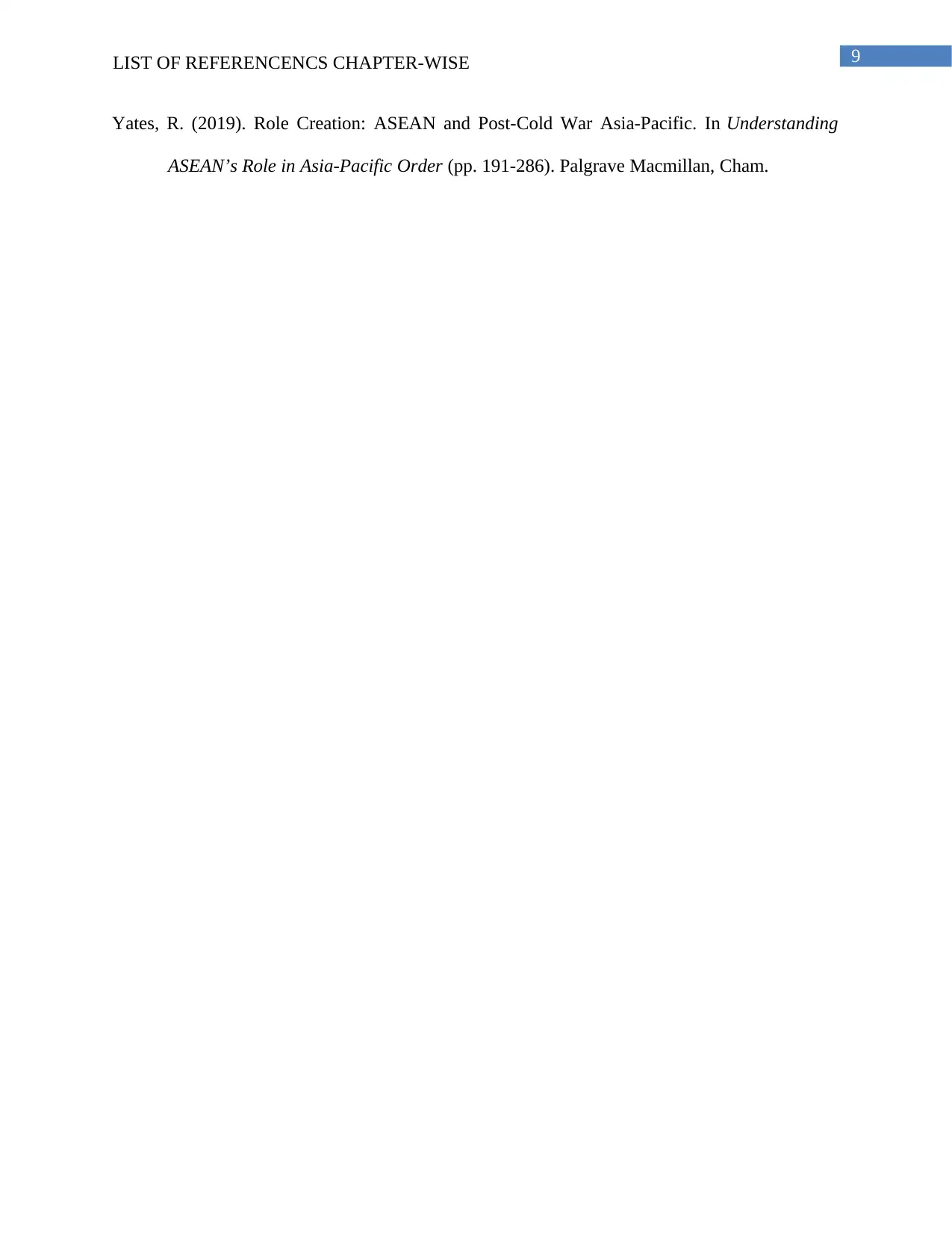
9LIST OF REFERENCENCS CHAPTER-WISE
Yates, R. (2019). Role Creation: ASEAN and Post-Cold War Asia-Pacific. In Understanding
ASEAN’s Role in Asia-Pacific Order (pp. 191-286). Palgrave Macmillan, Cham.
Yates, R. (2019). Role Creation: ASEAN and Post-Cold War Asia-Pacific. In Understanding
ASEAN’s Role in Asia-Pacific Order (pp. 191-286). Palgrave Macmillan, Cham.
1 out of 10
Your All-in-One AI-Powered Toolkit for Academic Success.
+13062052269
info@desklib.com
Available 24*7 on WhatsApp / Email
![[object Object]](/_next/static/media/star-bottom.7253800d.svg)
Unlock your academic potential
© 2024 | Zucol Services PVT LTD | All rights reserved.
